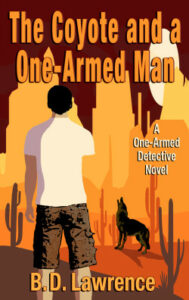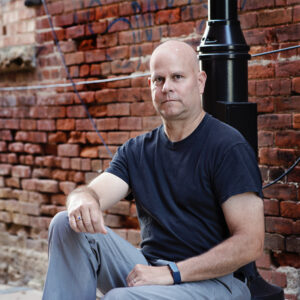by B.D. Lawrence @BDLawrence3
Some writers are plotters. They write a detailed outline of the entire story before writing a scene. Some writers are pantsers. They write with no outline and no idea where they are going. I started as a plotter. I wrote a wonderful ten-chapter outline for my first book. But when the book ended up being thirty chapters, that was the end of outlining. However, I also found I could not just plow ahead with no idea where I was going. I came up with a process that is a combination of the two extremes. It’s a technique I call scene ahead.
When I start a story or book, I generally know the beginning and the ending and the main characters. I’ll start by writing the opening scene. I always know that. Then, I write out a blurb for the next three to eight scenes. I tend to write linearly, so this works for me. If a later scene comes to me, I’ll write a blurb about it but then go back to the next chapter and work to toward it.
Here’s an example from my latest WIP. We’ll say I’ve finished chapter seven. Jake was arrested that morning. Here’s my scene ahead for the next three chapters:
Chapter 8 (Friday – July 16)
- Charges dropped. Lilianna convinced Patricci to drop them.
- She wants a report Monday 5pm.
- Jake visits Masewich at restaurant.
- Masewich has two skinheads with him.
- In parking lot Jake sees a black Trans Am with skinhead driving.
Chapter 9 (Friday)
- Alicia’s house. Thinks he sees a black car (Trans Am) when he gets out of his car.
- Had talked to a lot of snitches. No one would say anything about Masewich.
Chapter 10 (Friday)
- Followed by a Trans Am.
- Stops at gas station. Thinks he sees a white guy with shaved head driving.
- When he gets to his office, three skinheads are standing outside the building across the street.
- CP&P is Chris Payne (skinhead girl) and Patricci. Built a hotel next to the proposed casino site.
- Patricci paid off Arthur Goodhue for permits.
- Decide Monday to check out gambling and Aztar group.
That’s it. If you’re curious, chapter 8 is 2051 words, 9 is 2052 words and 10 is 2313 words. And at that point there was nothing for chapters 11 and beyond. Sometimes, the blurbs will be more detailed, but usually not that much detail. For example, this is part of the chapter 11 scene blurb, one of five bullet points:
Did Masewich fly back on Friday. Need to check airline and see if his ticket was used. It was. Eventually, needs to get security footage – not Abernathy that used the ticket as he never goes through security.
I’ll do three to eight of these at a time, depending on how much clarity I have for the next few scenes.
I like this approach because it gives me flexibility. Things can change and take a left turn when necessary. Here’s an example of an extreme case where the flexibility radically changed the course of the story.
An alternative to outlining or writing by the seat of your pants. Learn about scene ahead. @BDLawrence3 #ACFW #writingtips #writing #outlining Share on XIn my book The Coyote and the One-Armed Man, I had a scene where Lefty confronted Angel’s step-father because the guy kept calling Eileen (Lefty’s partner) about Angel. When there, a teenage girl appears wearing only a nightshirt. Lefty, whose calling is rescuing girls caught in trafficking, goes ballistic. After beating up the step-father, they take the girl (Darlene is her name) with them. Darlene says she’s not going home as her mom is on another binge. So, they take her to dinner to talk to her about the missing teenager they’re looking for. She ends up staying with Eileen that night and going to church with them the next day. During lunch the next day, Eileen asks Lefty, “What are we going to do with her?” Great question. And that was a question I was asking myself as I wrote her in.
Why do I recount this? Because there was no Darlene in the scene when I scened ahead. There wasn’t any teenager that was going to hang around with Lefty and Eileen as they searched for the missing girl. I had no early concept of Darlene. She just appeared. And once Darlene stepped onto the page, she never left. Darlene became one of my favorite characters and ended up playing a crucial role at the end of the book. Lefty became a father figure to her and she’s going to be in the next One-Armed Detective novel as well.
This is the flexibility my scene ahead approach gives me. With my latest novel, it took me up to the very last scenes to figure out how I wanted to end the story. I knew the epilogue I wanted, but not how to close down the case. If finally came to me, one scene at a time.
I don’t suggest everyone adopt this process. I put it out there as an alternative to plotting or writing by the seat of your pants. Works for me. And if you get anything out of my telling you about this, then I’ve accomplished my mission. Happy writing.
 During his writing journey B.D. Lawrence dabbled in several genres, including mystery, suspense, science fiction, fantasy, and literary fiction. He currently is focusing on crime stories of justice, vengeance, and redemption.
During his writing journey B.D. Lawrence dabbled in several genres, including mystery, suspense, science fiction, fantasy, and literary fiction. He currently is focusing on crime stories of justice, vengeance, and redemption.

Comments 9
“Scene ahead,” I like that idea. The Coyote and a One-Armed Man is a terrific read. Good luck on your current WIP!
Thank you.
This gives me food for thought – I’m more of a plotter than pantser, and in my internal conversations, I call myself a hybrid. This approach could work. Thanks for sharing your method.
You’re welcome. I am glad it was helpful.
That’s basically how I write. It’s akin to driving in the fog–you only drive as far as your headlights show you.
This is an interesting compromise between the two. I like it. I’m a panster who grabs a few things from plotters. Like you, I usually have the beginning and end of the story, and I can see where some of these three chapter blurbs could help move my process along. Thanks for your post.
No headlights on a moonless night;
what might lie ahead?
I never twigged at dawn I might
by noontime be quite dead,
but that is just what happened
as heart faltered and then tried to stop.
It was God and will that altered
fate, and let this man come out on top,
and thus, when I wrote stories
I had no plan nor sketched-out guile,
for one of the few glories
that made my words worthwhile
was that I had once learned to sing
a life, whatever time might bring.
I like your poem!
This scene-ahead is an interesting concept. It would probably work for the method I use – the hybrid, which uses a brief outline but allows for the joy of discovery. Thanks for sharing your method.